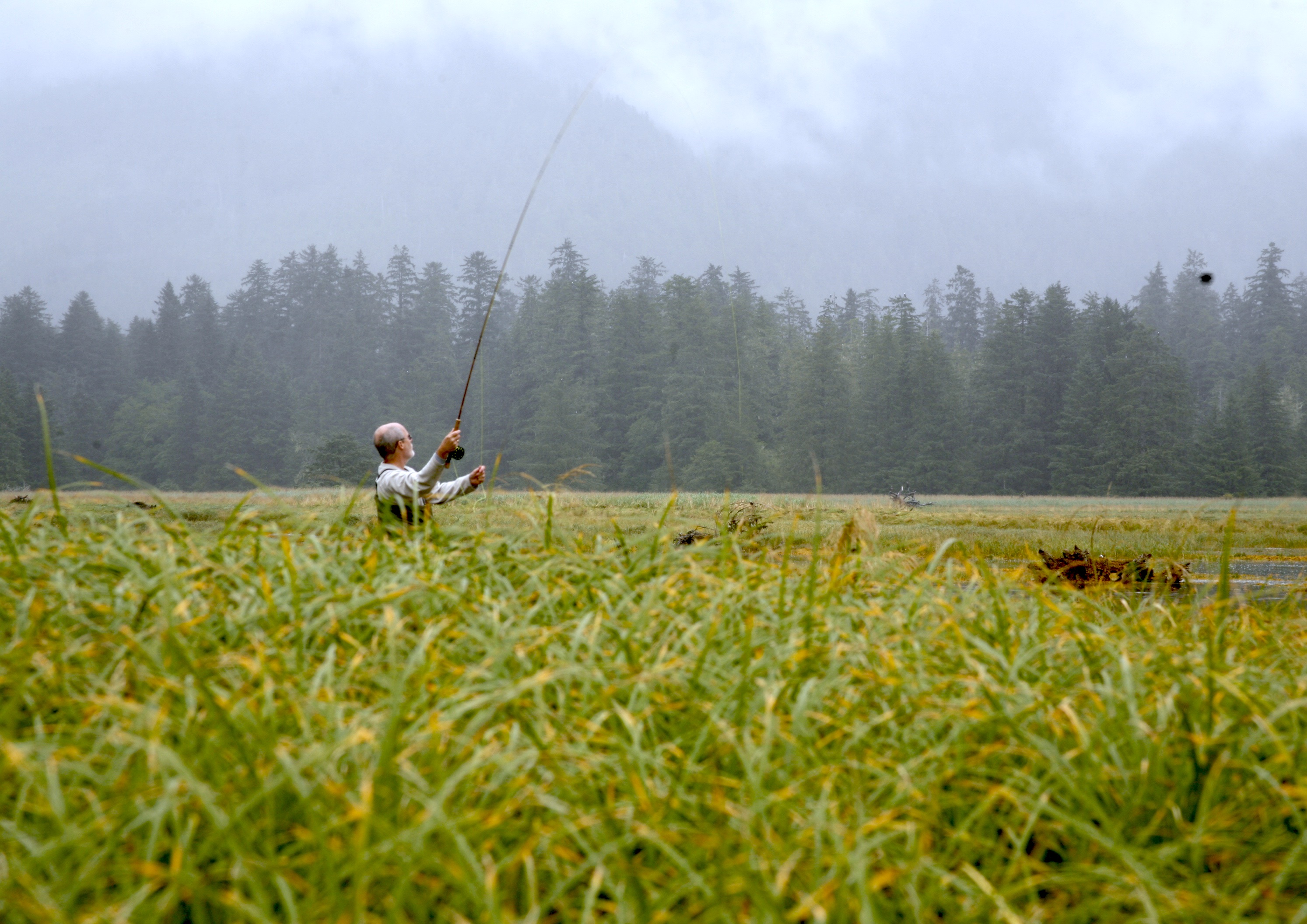
The silver salmon, or coho, is one of the most exciting sport fish in our waters and is taken from June to September. They hit salmon eggs, flies, spoons, or spinners. Weighing seven to fifteen pounds and growing as large as three feet long, silver salmon blanket the waters of Prince of Wales. One of the most popular runs is right off our dock at the mouth of Neck Outlet. With an early summer run of over 50,000 fish lasting for nearly six weeks, we have a jewel of a fishery. Fortunately, our remoteness assures relatively limited pressure on the fishery. In addition to our early summer run, anglers at The Lodge at Whale Pass will fish more traditional returns beginning in early to mid-August.
There are size and time limited sockeye salmon (red) runs available to The Lodge at Whale Pass angler every year. These fish are fresh from the ocean and are chrome silver. In Alaska, most sockeye salmon return to spawn in June and July in freshwater drainages that contain one or more lakes. Spawning itself usually occurs in rivers, streams, and upwelling areas along lake beaches. The red is a delicate feeder and requires equally delicate angling to land.
With their numbers in the millions, pink salmon (humpys) are the most abundant, shortest lived, and smallest of the Pacific salmon. Averaging three and one-half to five pounds and around two feet in length, these fighters begin clogging the shoreline as early as mid-June and really pile up by early August. We find pinks by the thousands in our bay running up the 108 Creek beginning in early August. Starting in late July we have a seemingly endless selection of waterways holding up Humpies, just within a short distance from the lodge. Some of our recommendations are Turn Creek, Bear Valley Creek, Log Jam Creek and the stream and outlet at Calder Bay.
The large and ferocious chum salmon (dog) has seen resurgence in our local area in recent years. Weighing in at five to almost twenty pounds, anglers are often amazed at just how much fun they have fishing the Dogs. These fish return to their home waters mostly in July and August after two to three years at sea. While guests can choose to target chum in areas such as Neets Bay, we mostly find these fighters among the silvers and pinks in the streams on the northwest corner of Prince of Wales. However, when targeted near river mouths prior to, or soon after, entrance into freshwater, chum salmon can provide excellent action on sport fishing gear.
Prince of Wales Island is a premier cutthroat trout fishing destination and we catch and release cuttys at virtually all of the pristine coastal streams we fish. Named for that distinctive red coloration on the underside of the lower jaw and gills, the average size is from ten to fifteen inches, though the occasional twenty inch plus fish, tipping the scales at over three pounds, keeps us on the hunt. We target both resident fish in the lakes and the more aggressive sea-run cuts as they navigate the rivers and streams of our coastal Alaska Panhandle. These fish provide a surprising amount of action. Some spots offer endless opportunities for hookups, including Luck Lake and its creek, Salmon Bay Lake and its creek, El Cap Creek, Bear Valley Creek and Red Bay Lake Creek.
The Alaska Dolly Varden, a member of the char family, is another one of our island’s most sought-after light tackle sport fish and fly fishing targets. The fish was named for the pink spots on its body similar to the dress worn by Dolly Varden, a character from the Charles Dickens novel ‘Barnaby Rudge.’ Our Dollies range in size from twelve to twenty-four inches and are particularly fun to catch on light tackle. Small spinning lures, streamer flies, salmon eggs and dry flies work well in streams and lakes. When they are hungry, they are voracious and will hit a variety of tackle. No matter the time of year, whether we’re targeting sea run or residents, it’s always fun to cast successfully at Dollies with spinners and both wet and dry flies.
The rainbow trout is one of the most respected and sought after of Alaska’s native game fishes. The state’s trophy rainbows are primarily caught in South Central Alaska, west of Anchorage. The streams and creeks of Prince of Wales Island boast a more serene ‘bow fishing experience, with catches commonly reaching 18 inches. Fishing success is typically greatest in the early and latter parts of The Lodge at Whale Pass season. Rainbow trout are voracious feeders and strong swimmers willing to hit a wide variety of lures, baits, and flies. Fly fishermen find that streamers, muddlers, and egg patterns fished near the bottom can do the trick, and numerous patterns in a variety of colors will work.The steelhead trout is a rainbow trout that has spent part of its life in the sea. On Prince of Wales Island, spring steelhead can be found in local streams from April through June. Medium-action spinning and fly rods with cast and retrieve methods work well. Steelhead will take several different types of tackle including baits, lures, wobbling spoons, weighted spinners, flies, streamers, muddlers, yarn and egg patterns. Fluorescent colors can sometimes work best and some populations will prefer certain colors over others.
Freshwater
Spin or flycast remote Alaska streams and lakes for salmon, trout, steelhead and more.
Best Gear
Enjoy custom designed cabin cruisers, Coast Guard certified guides and the latest rods, reels and tackle from industry leaders and local specialists.
The Regs
Buy your license online or we’ll get it for you at the lodge. We stay current on all catch regulations and promote sustainable fishing.

